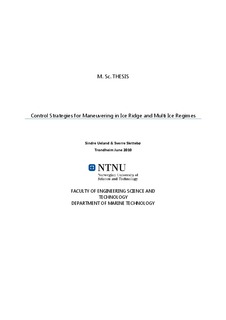| dc.contributor.author | Ueland, Sindre | nb_NO |
| dc.contributor.author | Slettebø, Sverre Wendt | nb_NO |
| dc.date.accessioned | 2014-12-19T12:06:11Z | |
| dc.date.available | 2014-12-19T12:06:11Z | |
| dc.date.created | 2010-12-08 | nb_NO |
| dc.date.issued | 2010 | nb_NO |
| dc.identifier | 375580 | nb_NO |
| dc.identifier.uri | http://hdl.handle.net/11250/237837 | |
| dc.description.abstract | Operations in an arctic environment are dependent on accurate, safe and reliable Dynamic Positioning (DP) systems. Increased activities in arctic environments have lead to a demand for knowledge of different ice regimes and their affection on offshore structures and vessels.
The purpose of this master thesis is to create a simulation tool for interaction between an ice ridge and a marine vessel and to propose a special purpose DP-system for use in arctic environment. The thesis has been divided into two parts. First an ice ridge model was created in order to realistically simulate an interaction between a marine vessel and an ice ridge. Secondly several DP-tactics for station keeping in arctic environment was proposed and tested against the ice ridge model.
Different theories and calculation methods regarding resistance from an ice ridges have been discussed. An ice ridge model was proposed and discussed, and a parameter analysis of the ice ridge model was performed. Ridge size, ridge velocity and vessel dimensions were varied to investigate the total resistance. Simulations showed that that the ice resistance varied with the different parameters. It was shown that increased vessel width will gave an increased bow resistance, while the mid body resistance remained unchanged. Comparison with available literature proposes that the keel and sail contribution of the total resistance is small. Drawbacks with the ice ridge model have been discussed and further work proposed.
An open-water DP-system was created and supplied with different ice breaking features to ensure station-keeping in a ridge-vessel collision. Five different features was described and discussed. Simulations of station keeping have been performed using the ice ridge model. Simulations of the open-water DP-system were used as a reference and for comparison with the special purpose DP-system. The different ice breaking features were then discussed and compared.
The simulation study indicated that the open-water control system may not offer optimal performance when exposed to ice ridge forces and that a special purpose controller should be considered. For a marine vessel subjected to an incoming ice ridge, simulation results showed improved station keeping abilities with use of a special purpose controller. However, the special purpose controller proposed in this master thesis assumes detailed knowledge about the incoming ice ridge. For a real world system such detailed knowledge about an incoming ice ridge would require an advanced sensor system, something that have not been considered in this thesis but proposed for further work. | nb_NO |
| dc.language | eng | nb_NO |
| dc.publisher | Norges teknisk-naturvitenskapelige universitet, Fakultet for ingeniørvitenskap og teknologi, Institutt for marin teknikk | nb_NO |
| dc.title | Control Strategies for Maneuvering in Ice Ridge and Multi Ice Regimes | nb_NO |
| dc.type | Master thesis | nb_NO |
| dc.contributor.department | Norges teknisk-naturvitenskapelige universitet, Fakultet for ingeniørvitenskap og teknologi, Institutt for marin teknikk | nb_NO |
